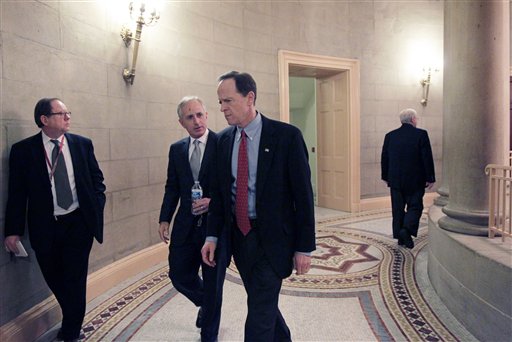As the nation nears its borrowing limit on Oct 17, the Treasury Department and half of Congress ramp up warnings of a potentially global economic catastrophe without a debt ceiling hike – but with just over a week to the deadline, Senate budget buffs and economist think tanks grow vocally skeptical with how real the danger of default is.
Videos By Rare
“We always have enough money to pay our debt service,” North Carolina Republican Sen. Richard Burr said Tuesday in the New York Times. “You’ve had the federal government out of work for close to two weeks; that’s about $24 billion a month. Every month, you have enough saved in salaries alone that you’re covering three-fifths, four-fifths of the total debt service, about $35 billion a month. That’s manageable for some time.”
A member of the Senate Finance Committee, Burr makes an argument vastly under-reported in the doomsday headlines dominating Capitol Hill’s debt ceiling coverage. In addition to the revenue generated by not paying government salaries – which it is worth noting will be back-paid when the government reopens – Treasury continues to receive unpredictable amounts of revenue in its millions of transactions daily, making an exact default date difficult to determine.
That argument seems to coincide with a Monday memo from top national credit rating agency Moody’s.
“We believe the government would continue to pay interest and principal on its debt even in the event that the debt limit is not raised, leaving its creditworthiness intact,” the memo says. “The debt limit restricts government expenditures to the amount of its incoming revenues; it does not prohibit the government from servicing its debt. There is no direct connection between the debt limit (actually the exhaustion of the Treasury’s extraordinary measures to raise funds) and a default.”
Moody’s went on to say the danger is much smaller than it was in 2011, when the agency itself issued compelling warning in light of a significantly higher deficit than in 2013. The last minute raise by Congress still resulted in a credit rating downgrade by the Standard & Poor index, which rebounded earlier this year.
“There’s zero chance that the U.S. government is going to default on its debt. It’s unfortunate that people have conflated this idea of not raising the debt ceiling immediately on Oct. 17 and somehow defaulting on our debt,” Pennsylvania Republican Senator and Banking Committee member Pat Toomey said Wednesday on MSNBC, reiterating that tax revenue would bring in enough for Treasury pay interest on its loans.
In a Wednesday letter to President Obama, Senate Republicans said the administration’s warnings “are not only misleading in our view, but they threaten to destabilize financial markets and could raise borrowing costs for families and small business.”
The letter states the U.S. “cannot and will not default on its debt, with some members furthering the argument that the Treasury Department brings in enough revenue to make the necessary interest payments on U.S. debt. Republicans however did concede that raising the debt ceiling was an eventual inevitability anyway.
“But I think the real date, candidly, the date that’s highly problematic for our nation, is Nov. 1,” Tennessee Republican Sen. Bob Corker, another Senate Banking Committee member, said in the New York Times Tuesday.
Treasury faces about $73 billion in outgoing payments to bond interest, Social Security, Medicare, civil service and military by Halloween according to the Congressional Budget Office, with Treasury Secretary Jack Lew continuing to insist he will be left with only $30 billion in cash reserves by mid-October without a debt ceiling raise.
“The one thing we know for sure is that by Nov. 1, they will be out of money,” Goldman Sachs analyst Alec Phillips said in The Hill on Tuesday.
Related articles
- How Debt Ceiling Deniers Are Reinforcing Voter Ignorance (usnews.com)
- Toomey: ‘Zero chance’ of default (politico.com)
- Sperling: Era of threatening default is over (politico.com)

